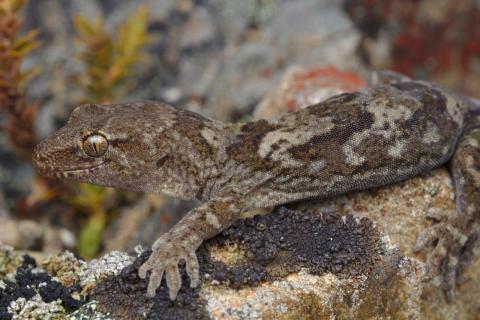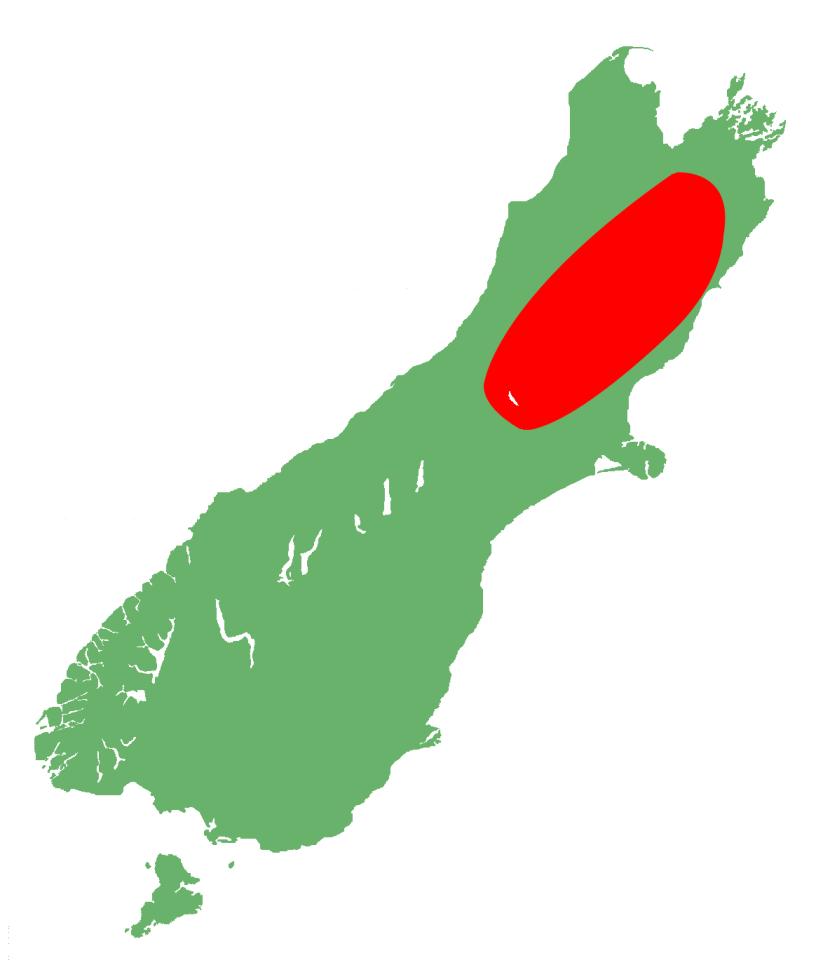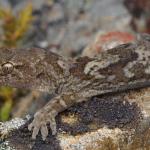- Home
- Herpetofauna Index
- Native
- Woodworthia "Southern Alps Northern"
Woodworthia "Southern Alps northern"
Greywacke gecko
Woodworthia "Southern Alps northern"

Length: SVL up to 72mm, with the tail being equal to or slightly longer than the body length
Weight: 5-10 grams
Description
The greywacke gecko (or northern Southern Alps gecko) was previously considered synonymous with the Southern Alps gecko (Woodworthia "Southern Alps"). However, recent analyses have distinguished these two taxa due to marked genetic and geographic separation. Accordingly, they are thought to be two distinct species (Hitchmough et al., 2021). Greywacke geckos generally have a grey, brown, olive, or pinkish dorsal surface, often with pale markings. Their ventral surface is typically pale brown or grey. Their mouth interior is pink, with a pink tongue (van Winkel et al. 2020).
Separated from the Southern Alps gecko by the Rakaia River, although vary slightly in morphology:
- The greywacke gecko is often larger, darker grey/brown in colour, and less stocky, with a longer neck, less finely divided markings and usually lacking the canthal stripe.
- The Southern Alps gecko varies in body size considerably between individual populations over quite short distances. Neck and snout stocky with a prominent canthal stripe. Silvery grey in colour.
Range abuts:
- Minimac gecko (Woodworthia "Marlborough mini") smaller, distinguished by warmer lighter background colour, and with distinctive head markings (narrow stripe through eye continuing to back of the head) and rostral scale well separated from nostrils.
- Raukawa gecko (Woodworthia maculata) in the Kaikōuras, found at lower altitudes, and usually with more contrasting black and brown markings, distinctly longer distal phalanges, a longer snout, longer intact tail, spiny ‘eyebrows’ and brown (vs. green) eyes.
- Pygmy gecko (Woodworthia "pygmy") in north Canterbury and south Marlborough. Frequently found together under the same rock. Pygmy gecko much smaller, with narrower toes and fewer lamellae (7–9), and rostral scale well separated from nostrils.
Life expectancy
Unknown, but likely to be similar to other Woodworthia e.g. up to 50+ years.
Distribution
The greywacke gecko occupies the eastern Southern Alps in southern Marlborough down to the northern banks of the Rakaia River. Northern outlier population in Wairau Valley.
Ecology and habitat
Generally nocturnal but occasionally seen basking in daylight. Primarily terrestrial and saxicolous (rock-dwelling), but is known to climb into small trees and shrubs. Greywacke geckos live at lower elevations between mountain ranges, but also range up into the alpine (1800 metres a.s.l). They can be found in the stable bases of scree slopes, rocky river terraces and shattered outcrops in dry sub-alpine. They are primarily associated with greywacke rock formations.
Social structure
Found both solitary and communally, in population groups of up to a dozen or more.
Breeding biology
Twin viviparous offspring born late summer. Likely biennial in high altitude populations.
Diet
Likely feeds on a combination of invertebrates, nectar and seasonal fruit.
Disease
Unknown.
Conservation strategy
This species is not being actively managed. Given the common occurrence and wide range of this species, it is regarded "At Risk: Declining" (Hitchmough et al., 2021).
Interesting notes
The common name greywacke gecko refers to the predominant rock type found within the known distribution of this species, whilst its TAG name both refers to its distribution and relationship with its sister species - the Southern Alps gecko.
Greywacke geckos are members of the 'common gecko' complex, a group of closely related species which are regionally distributed throughout New Zealand. Historically, most of these were considered a single highly-variable species - Hoplodactylus maculatus (the so called 'common gecko'). The 'common gecko' has now been separated into over ten different species.
The greywacke gecko, along with its sister taxa the Southern Alps gecko sit within the Southern clade of the Woodworthia complex, with the kōrero gecko (Woodworthia "Otago/Southland large") being their closest relative within the group.
References
Jewell, T. (2008). A photographic guide to reptiles and amphibians of New Zealand. Auckland: New Holland.
van Winkel D, Baling M, Hitchmough R (2019): Reptiles and Amphibians of New Zealand, A Field Guide. Auckland University Press, Auckland, New Zealand.



